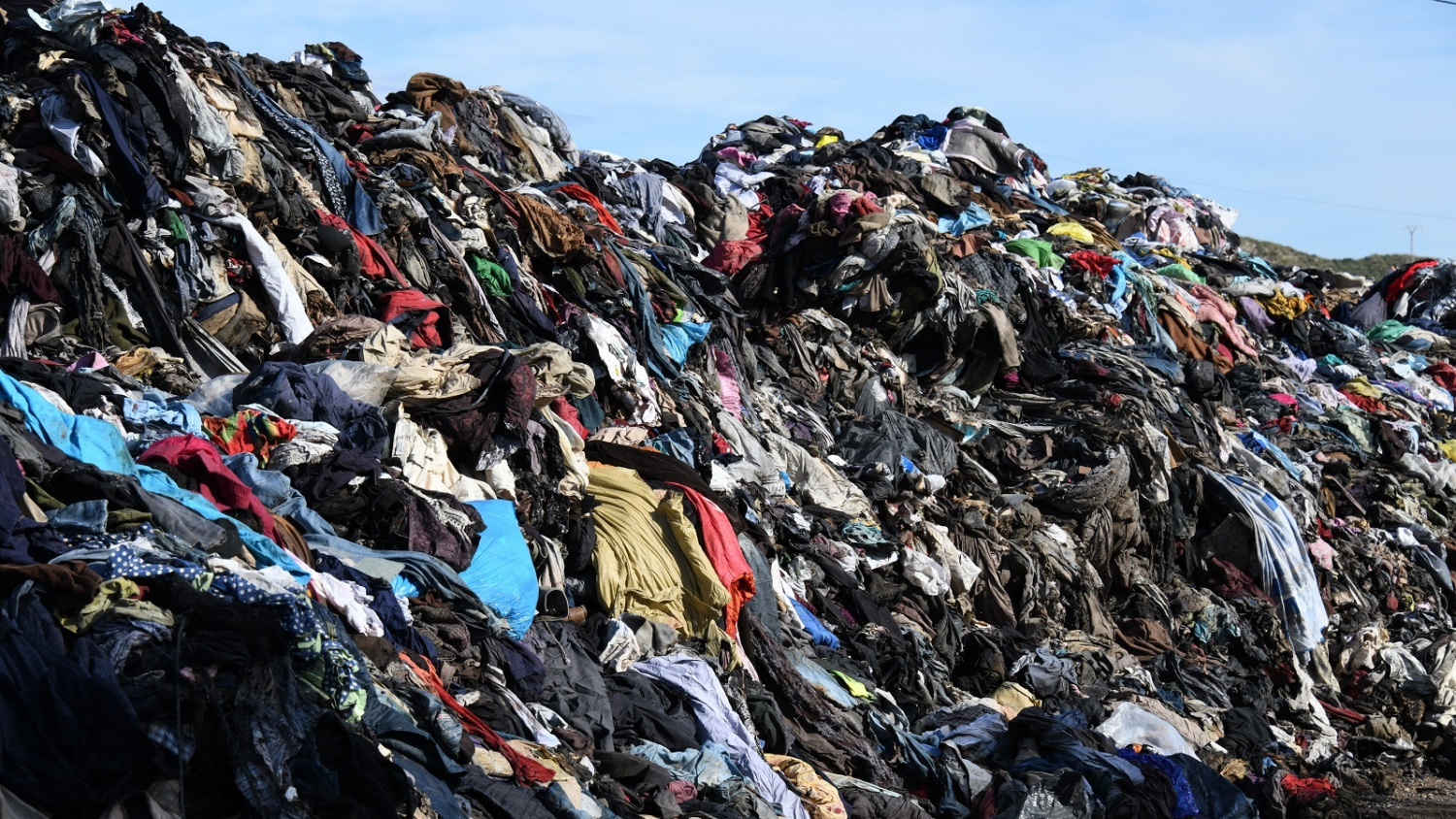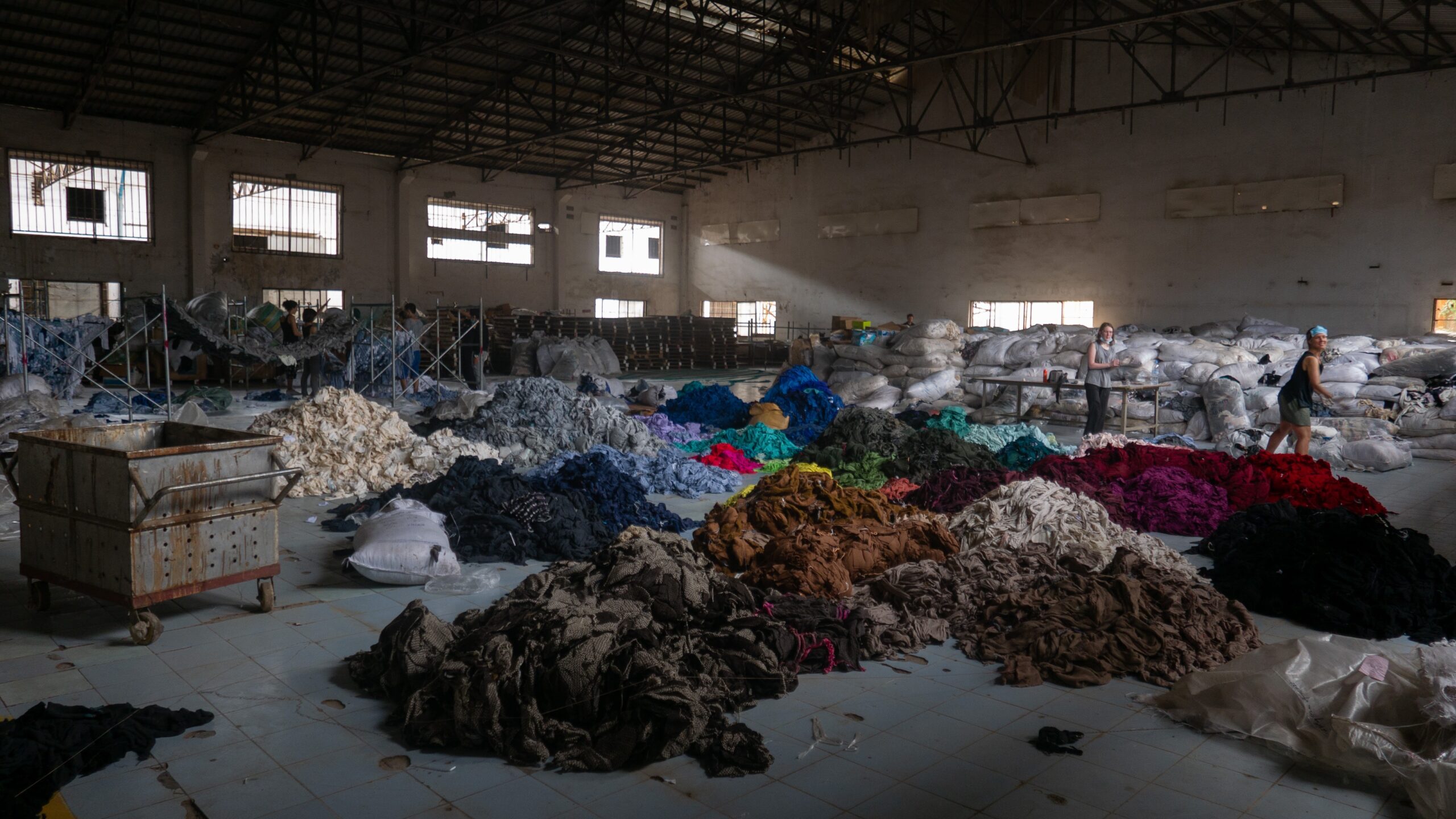Textile waste is a growing burden to our planet and vulnerable communities. Extended Producer Responsibility (EPR) is a promising policy tool that holds producers accountable for managing their products after they are used. If done correctly, it could create new incentives for better textile design, less harmful textile systems, and reduce textile waste overall.

The Causes and Consequences of Textile Waste
What happens to our clothes after we are done wearing them? Whether they get donated, repurposed, or recycled, our clothes’ journey is far from over. Textile recycling infrastructure is currently extremely limited or nonexistent in most areas, creating barriers to repurposing fiber materials at a local level. We can choose to donate, but secondhand stores are increasingly overburdened by the sheer volume of donations — only about 10-15% of donated clothing ends up on the shelves of domestic thrift stores. The remainder is either sent directly to landfills or, increasingly, shipped to overseas secondhand markets. The amount and quality of these exported textiles results in cycles of debt and exploitation for secondhand retailers and workers, as well as severe environmental pollution and public health consequences.
According to the U.S. Environmental Protection Agency (EPA), textiles comprised 4.5 percent of our waste stream in 2017, totaling 14.3 million tons.(1) The average person in the United States dumps 81 pounds of clothing each year — an increase of 55 percent per capita since 2000. This increase can largely be traced to the emergence and popularity of the fast fashion industry, which props up the sale of low-cost, low-quality clothing that goes out of fashion with increasing speed. The rise of fast fashion contributes to a “disposability” mindset that incentivizes a linear supply chain with no regard for the burden at the other end of the spectrum.
 The U.S. is the largest exporter globally of secondhand textiles, among an annual global trade of 4.5 million metric tons of waste garments. The fashion industry uses the “receiving” communities that participate in the global secondhand clothing trade as a defacto waste management strategy. However, more people are calling for collective action and accountability in this harmful and broken system, which enables the Global North to obscure and ignore the damage caused by a culture of overconsumption by passing waste from financially wealthier countries to countries with scarce resources and infrastructure to safely manage it. In a recently published position paper, Stop Waste Colonialism, The Or Foundation describes the burden placed on these communities and shares recommendations for policies that can account for decades of exploitation.
The U.S. is the largest exporter globally of secondhand textiles, among an annual global trade of 4.5 million metric tons of waste garments. The fashion industry uses the “receiving” communities that participate in the global secondhand clothing trade as a defacto waste management strategy. However, more people are calling for collective action and accountability in this harmful and broken system, which enables the Global North to obscure and ignore the damage caused by a culture of overconsumption by passing waste from financially wealthier countries to countries with scarce resources and infrastructure to safely manage it. In a recently published position paper, Stop Waste Colonialism, The Or Foundation describes the burden placed on these communities and shares recommendations for policies that can account for decades of exploitation.
Stop Waste Colonialism depicts the environmental, economic, and social consequences of fashion waste on communities “downstream” from the Global North. Centering the direct experiences and stories of the people processing textile waste in the Kantamanto Market in Accra, Ghana, The Or Foundation identifies key recommendations for leveraging Extended Producer Responsibility (EPR) to stop the devastating impacts of the fashion industry and incentivize a circular economy that reduces waste, ensures economic opportunities, and regenerates the environment.
Here’s an excerpt from the Stop Waste Colonialism website:
Kantamanto is a place, a culture, and a community, a community on the receiving end of a colossal problem and a community that is contributing more to circularity than any company in the Global North.
The fashion industry produces more clothing than we can consume and the Global North consumes more than they can use. At the end of fashion’s oversupplied linear economy is Kantamanto Market in Accra, Ghana, the largest secondhand clothing market in the world. If you have ever donated clothing to a charity shop or put your clothing in the “recycling” bin down the street, there’s a good chance your garments ended up here. [..]
Kantamanto Market is on the receiving end of fashion’s waste crisis. Every week, 15 million garments arrive from countries across the Global North and 40% leave as waste, often within one or two weeks of landing at port. This waste ends up in burn piles around the city, dumped in informal settlements where it pollutes the backyards of Accra’s most vulnerable citizens or it is washed out to sea. This waste has plunged retailers into debt (it is not free), decimated the local fashion ecosystem and created an economy reliant on cheap and dangerous labor, with young women working as kayayei (head porters) literally being crushed to death by the weight of the clothes they carry.
There is an urgent need for global accountability and policy mechanisms that hold producers accountable for the financial and physical work of processing fashion waste. Extended Producer Responsibility provides a framework that shifts the responsibility to the producers to combat the inequitable consequences of growing textile waste.
A Call for Global Accountability: Extending Product Stewardship to Clothing and Textile Brands
A justice-led transition from a linear textile economy to a circular textile economy is possible, and a concept known as Extended Producer Responsibility (EPR) could help catalyze this transition. EPR is a policy tool and form of product stewardship that extends a producer’s responsibility for a product to the post-consumer state of a product’s life cycle. (3) The goal of EPR is to “transition from a linear to a circular economy through overall waste reduction, environmental regeneration and through dignified economic opportunities via fiber-based recycling, upcycling and decomposition pathways.” (4) EPR programs can include organizational and financial commitments, ensuring that producers provide services and funding to manage products after their use phase.
A goal of EPR programs is to cultivate circularity: the cycling of products through phases of use, re-use, repair, and recycling while minimizing or eliminating waste. It’s important to note that circularity alone does not address the larger systemic impacts of current textile overproduction, pollution through microplastic emissions from textiles, or plastic use and impacts. Well-designed EPR policy can be inclusive of all these issues, which are clearly integral to textile waste and its impacts.

It is also critical to recognize that true circularity for textiles can only exist when materials harmonize within nature’s cycles. Textiles are products that inherently release fibers (microfibers) constantly as they are used, worn, or washed. That means some portion of the wool, cotton or plastic fibers that make up a garment are continually released into the environment throughout their lifetime of use. These microfibers can cycle healthfully back into our ecosystems if they are made from natural fibers without any harmful additives. If they are made of plastic fibers, they become a persistent and widespread pollutant in our waters, air, and soil. These are impacts that should be considered under producer responsibility programs.
An international coalition of natural fiber industry and advocates, Make the Label Count (MTLC), has offered insight on how targeted EPR programs with adjustable fees based on actual textile waste data can help to solve more systemic issues: “Ensuring products are designed in respect of circularity principles will not be enough to stem overproduction and overconsumption. To address these issues, we need to talk about production frequency and volume, use patterns and waste management of products… those who pollute the most, i.e. those who frequently place large volumes of products on the market that are never used or have a short service life, and/or ensuing expensive waste treatment, will pay the most. On the other hand, brands whose products are rarely found in the waste streams, or whose products incur low costs when treated as waste, would pay very little.” (5)
An ideal application of EPR would be to assign fees on all textile producers that are adjusted according to production volumes and to costs due to product longevity and recyclability. These fees must be set sufficiently high to affect product design, production volumes, and material choice to create a more favorable economy for products that pollute less and are likely to be used longer. This framework would ensure that waste streams are defined, transparent, and measurable, while developing infrastructure so that more textiles can be recycled and reused.
Although several countries and states are developing or considering EPR programs for textiles, the only textile-based EPR program operating currently is in France. There is an opportunity to incorporate key principles from the Or Foundation’s position paper to improve existing and future EPR programs both in the E.U. and the U.S. These include:
- Internalized Cost of Waste Management: EPR Fees must align with eco-modulated waste management costs throughout the global reverse supply chain and must financially incentivize alternatives to linear waste practices.
- Global Accountability: EPR programs must align with the reality of how waste flows around the world, distributing funds to enable circular infrastructure in the Global South as well as the Global North and to account for the loss and damage already incurred by fashion’s excessive waste sent around the world to under-resourced and climate vulnerable communities.
- Disclosures to Drive Circularity Targets: In order to achieve eco-modulated EPR Fees, programs must require companies to disclose production volumes along every eco-modulation tranche. The Or Foundation calls for this information to be publicly available on a per company basis and for reduction targets for new clothing of at least 40% over five years, balanced by the increase of reuse and remanufacture of existing materials.
You can stand with the Kantamanto community and advocate for a justice-led transition to a circular economy by signing your name to the Stop Waste Colonialism position paper.
California Advances Legislation to Reduce Textile Waste
California is the first U.S. state to introduce EPR legislation attempting to mitigate the clothing industry’s staggering impact on the environment and overseas markets. The proposed bill, SB 707 (Newman), would create an EPR program for the implementation and management of an end-to-end system to optimize the recycling or repair of textiles. The bill would require reporting on the quantities, types, and fate of materials collected, in order to reduce the amount that ends up in landfills or in overseas markets.

There are several components of California’s EPR model worth noting. The first is that Californians would still be able to bring their unwanted clothing and textiles to thrift stores, charities, and other sites for donation, but these sites would then also be a part of a larger statewide system for collecting and sorting used textiles that cannot be reused or resold. If passed, the program would provide funding for washing, repair and recycling of collected textiles, with increasing targets over time for the percentage of waste diverted from landfill. SB 707 also includes education and outreach components to encourage Californians to bring their used textiles to accessible collection points for sorting, including items previously rejected by thrift stores (such as damaged items, used pillows and bedding, etc.)
California’s SB 707 could be a significant model for other states and countries. The bill’s sponsor, California Product Stewardship Council (CPSC), has led the development of EPR programs in the state for several other industries. Just a few weeks ago, another textile EPR bill was introduced in New York, S6654.
To learn more about the EPR policy being proposed in California, we encourage you to explore the California Product Stewardship Council’s website. If you live in California, you can sign on to support the legislation here.
—
